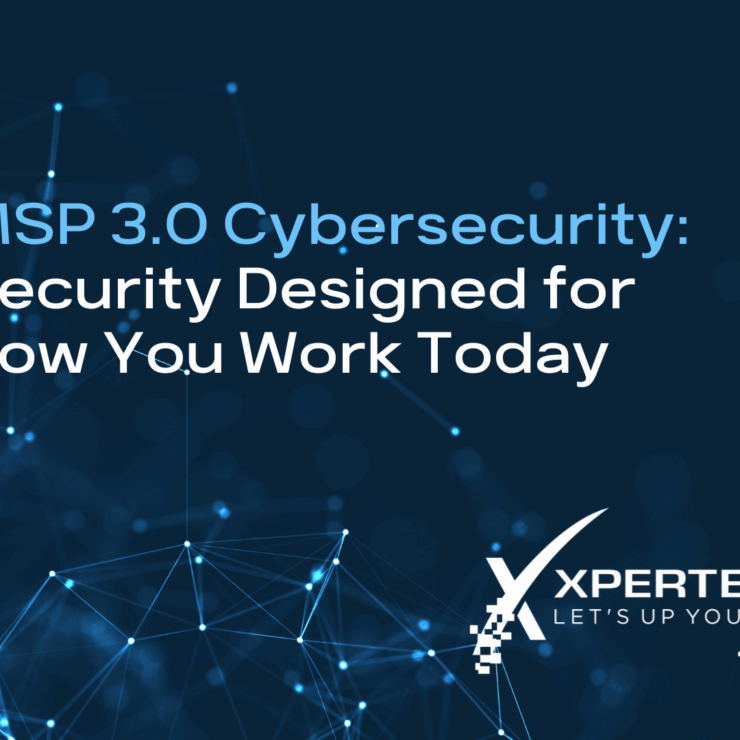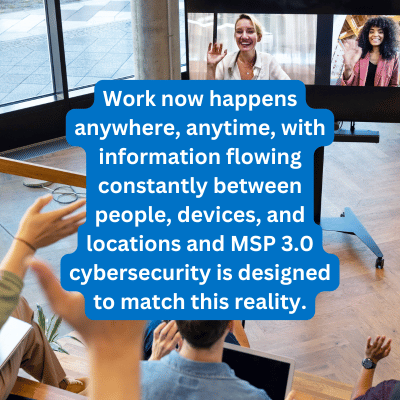MSP 3.0 Cybersecurity: Security Designed for How You Work Today

Modern work has fundamentally changed, but in many cases, IT security hasn’t kept up. Work now happens anywhere, anytime, with information flowing constantly between people, devices, and locations – not employees always at their desks, with data on servers, and work confined to business hours. At XPERTECHS, our MSP 3.0 cybersecurity is designed to match this reality.
What does that reality look like? Your accounting manager logs in at 9 PM Thursday to process vendor invoices before month-end closes. Your construction superintendent uploads project photos from the job site and updates schedules on his tablet. Your legal team collaborates on case files with attorneys across three time zones, sharing sensitive documents through cloud platforms.
When there’s a disconnect between how businesses operate and how cybersecurity works, dangerous gaps in protection emerge. At XPERTECHS, our Managed Service Provider (MSP) 3.0 cybersecurity addresses these gaps.
What is MSP 3.0 and how is it designed for modern work reality? Let’s first look at why traditional cybersecurity falls short.
Table of Contents
Why Traditional Cybersecurity Falls Short

Traditional cybersecurity was designed for a world that no longer exists. Employees worked at desks connected to company networks. Sensitive information stayed on company servers behind firewalls. IT support monitored systems during business hours.
That model breaks down when your team works across time zones, accesses company data from personal devices, and collaborates through cloud platforms that don’t respect traditional security boundaries.
Consider this scenario: your employee’s account gets compromised at 8 PM Saturday. Traditional MSP security monitoring sends an alert that waits for someone to respond Monday morning. By then, cybercriminals have had an entire weekend to access sensitive data, change authentication settings, and establish ongoing access to your systems.
Or consider this: an employee downloads project files to work on at home, then shares them with a subcontractor via email. Later, they access the same files from a coffee shop while traveling to meet a client.
Conventional MSP security monitors your office network but has no visibility into where that data went, who has copies now, or whether those access points were secure.
XPERTECHS’ MSP 3.0 Security Approach
These scenarios reveal why cybersecurity had to evolve. At XPERTECHS, we call the evolved approach MSP 3.0 cybersecurity. MSP 3.0 providers act as strategic business partners who understand your operations, not just IT service providers who maintain systems.
For cybersecurity, this means protection built around how your business works – distributed teams, mobile data, and flexible work schedules. Instead of monitoring systems and sending alerts, MSP 3.0 cybersecurity provides immediate threat containment, data protection that travels with information, and security that accounts for the possibility that people will click things they shouldn’t, share information accidentally, and make other security mistakes.
MSP 3.0 cybersecurity involves many complexities – new threats, changing work patterns, and evolving tools. And security strategy has many layers including compliance requirements, tool selection, policies, and procedures. All these components must work together to accomplish three main functions.
Related: Learn about the More Know-How part of MSP 3.0
Three Core Functions of Strategic Cybersecurity
1. Protect Identities and Devices Wherever They Are
Without a set network perimeter, you must secure identities and devices wherever they are.
This requires 24/7 Managed Detection and Response (MDR) that goes beyond traditional monitoring. When the system detects unusual activity – like an account logging in from a new location – it can be configured to immediately lock down the account first, then alerts the security team.
It’s better to have someone locked out for a few hours due to a false positive than let a real security incident run undetected all weekend.
2. Protect Information Wherever It Goes
Documents get downloaded, emailed, shared with AI platforms, and accessed from multiple locations. Security that only protects where information is stored can’t protect where information travels.
This requires embedded data protection like Microsoft Purview that encrypts files with security controls that stay with the document wherever it goes.
With data loss protection measures in place, if someone leaves your company after downloading files, they won’t be able to access them because the encryption requires active authentication. The same protection prevents unauthorized recipients from opening accidentally shared documents.
3. Equip People to Protect Accounts and Data
People will click suspicious links and share information inappropriately – it’s human nature. But a comprehensive security strategy equips people to be your first line of defense.
This requires ongoing cybersecurity awareness training combined with systems that immediately contain threats when mistakes happen. It’s better to prevent an intrusion than detect it after the fact, but you need both layers of protection.
The goal is to build cybersecurity literacy and create a culture where security becomes second nature, not an afterthought.
The Business Impact of MSP 3.0 Cybersecurity

When you protect identities everywhere, safeguard information that travels, and equip people with security literacy, cybersecurity provides comprehensive risk management that enables confident business operations.
What’s more, strong security foundations enable you to confidently adopt AI, automation, cloud collaboration, and flexible work arrangements that improve operational efficiency. That means that while competitors deal with security incidents and compliance gaps, you can focus on growth opportunities.
MSP 3.0 Cybersecurity Designed for Today’s Work Reality
MSP 3.0 is cybersecurity designed for how you work today, not how businesses operated just a few years ago. At XPERTECHS, our MSP 3.0 approach combines advanced security technology with understanding of your business operations to create protection that matches your modern work reality.
Ready to move beyond traditional cybersecurity approaches? Let’s discuss how MSP 3.0 cybersecurity could provide the comprehensive risk management your business needs.
Get in touch to schedule a cybersecurity strategy consultation.
Frequently Asked Questions about MSP 3.0 Cybersecurity
How is MSP 3.0 cybersecurity different from traditional perimeter-based security?
Most MSPs provide cybersecurity designed for office-based work with clear network boundaries. MSP 3.0 cybersecurity is built for modern workplace reality – distributed teams, mobile information, and flexible work schedules. We protect identities and data wherever they go instead of trying to secure perimeters that don’t exist anymore.
Why is 24/7 monitoring necessary if we have good security tools?
Security tools detect threats, but immediate response prevents small incidents from becoming major breaches. Cybercriminals often attack outside business hours when response is delayed. Our 24/7 managed detection and response provides immediate threat containment regardless of timing.
What makes data protection different from regular file security?
Traditional file security protects where information is stored. Modern data protection travels with information wherever it goes. Even if sensitive documents get downloaded, emailed inappropriately, or shared with unauthorized recipients, the embedded encryption prevents access without proper authentication.
How do you handle the reality that employees will make security mistakes?
We assume human error will happen and focus on immediate containment when it does. Instead of just training people to avoid mistakes, our security systems detect suspicious activity resulting from human error and contain threats within minutes. The goal is to prevent small mistakes from becoming business disasters.
What business outcomes should we expect from strategic cybersecurity?
Strategic cybersecurity enables confident adoption of growth-driving technologies like AI automation and cloud collaboration. You’ll experience fewer security-related operational disruptions, stronger protection for business-critical processes, and competitive advantages that come from superior security posture.
